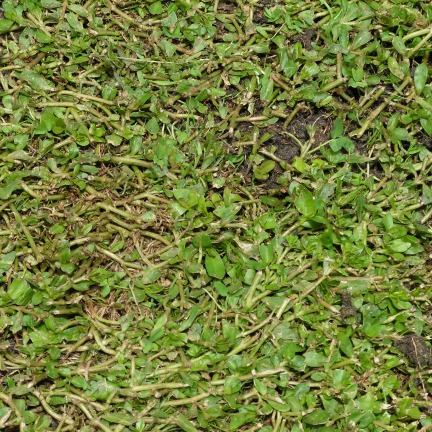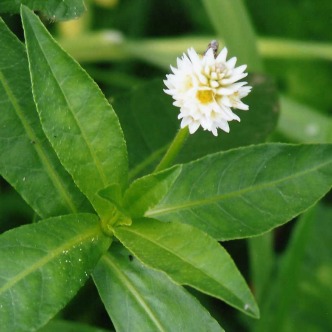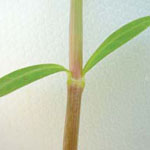Alligator weed
Alligator weed (Alternanthera philoxeroides) is a State prohibited weed.

If you find alligator weed
If you think you may have seen alligator weed, please contact us by:
- completing this form
- calling our Customer Service Centre on 136 186, or
- emailing weed.spotters@agriculture.vic.gov.au
Please do not attempt to treat or dispose of this weed yourself. We will treat, remove and dispose of alligator weed safely, at no cost to the land owner.
Why you must report alligator weed
Alligator weed is a native of South America and is regarded as one of the worst weeds. It is a declared noxious weed in all states and territories of Australia because of its potential to cause harm to the economy and environment.
Infestation mats can cover an extensive area, causing major blockages of waterways that impact on irrigation practices and recreational activities.
When it grows on farmland, cattle and lambs grazing on alligator weed can have higher sun sensitivity. This can result in skin lesions, liver damage and death.
Alligator weed is a particularly hard weed to eradicate because it invades both land and water. In waterways, it can grow from plant fragments dispersed from a parent infestation and produce new infestations downstream.
Alligator weed in Victoria
Alligator weed has mostly been found in south-east Melbourne backyards, although a few regional backyard infestations have also been detected. Waterway infestations have also been found in Melbourne and in regional Victoria, at Bendigo and Warragul.

Identifying alligator weed
This is alligator weed. Alligator weed grows in the water or on the ground.
When it grows in the water it can float on top of the surface or be attached to the bank. It can also grow in a garden situation as an upright stand, or creeping amongst other vegetation, or flat in the lawn.
Alligator weed leaves are bright green and grow in opposite pairs along the stem. The stems are hollow and the flowers grow in papery round balls on individual stalks.
The roots of alligator weed are long and fibrous, and where the stems have joints and come into contact with the water, the plant will take root.===END TRANSCRIPT===
On water it can be free-floating or attached to the bank.

On land it can grow upright, creeping among other vegetation, or grow flat along the ground.

Flowers are papery and ball shaped, silvery-white in colour and grow on individual stalks.

Roots grow from joints in the stem. These can break off and form new infestations downstream.
The leaves of alligator weed are bright green and spear-shaped. They grow in opposite pairs along a hollow stem.

Lookalike species
Alligator weed can be mistaken for other species, such as lesser joyweed (Alternanthera denticulata), an Australian native. However, the leaves of lesser joyweed are not as green or glossy as those of alligator weed and the flowers are in the leaf axil, not on flower stalks.
Mukunuwenna or sessile joyweed (Alternanthera sessilis) is also similar, however the leaves are shorter and rounder. Alligator weed has been mistakenly grown as this vegetable in Victorian gardens
Wandering trad (Tradescantia fluminensis) is also sometimes confused with alligator weed but has an alternating leaf arrangement and not an opposite arrangement like alligator weed.
Alligator weed 3D model
The New South Wales Department of Primary Industries has developed 3D (three-dimensional) models to help people become more familiar with prohibited invasive plants, including alligator weed, by providing a lifelike representation.
The model can be manipulated and inspected at every angle and magnification and is a great way to become more familiar with alligator weed.
© Regional NSW through NSW DPI Invasive Species Biosecurity. Model created by Rachel Klyve.
Explore 3D modelHave you seen this weed?
Information in other languages
We've developed factsheets about alligator weed in some other languages:
- Alligator weed factsheet – Karen
 [PDF File - 503.2 KB]
[PDF File - 503.2 KB] - Alligator weed factsheet – Khmer
 [PDF File - 274.7 KB]
[PDF File - 274.7 KB] - Alligator weed factsheet – Simplified Chinese
 [PDF File - 587.7 KB]
[PDF File - 587.7 KB] - Alligator weed factsheet – Sinhalese
 [PDF File - 473.0 KB]
[PDF File - 473.0 KB] - Alligator weed factsheet – Tamil
 [PDF File - 942.9 KB]
[PDF File - 942.9 KB] - Alligator weed factsheet - Hindi
 [PDF File - 438.6 KB]
[PDF File - 438.6 KB] - Alligator weed factsheet - Hindi (accessible)
 [MS Word Document - 6.5 MB]
[MS Word Document - 6.5 MB]